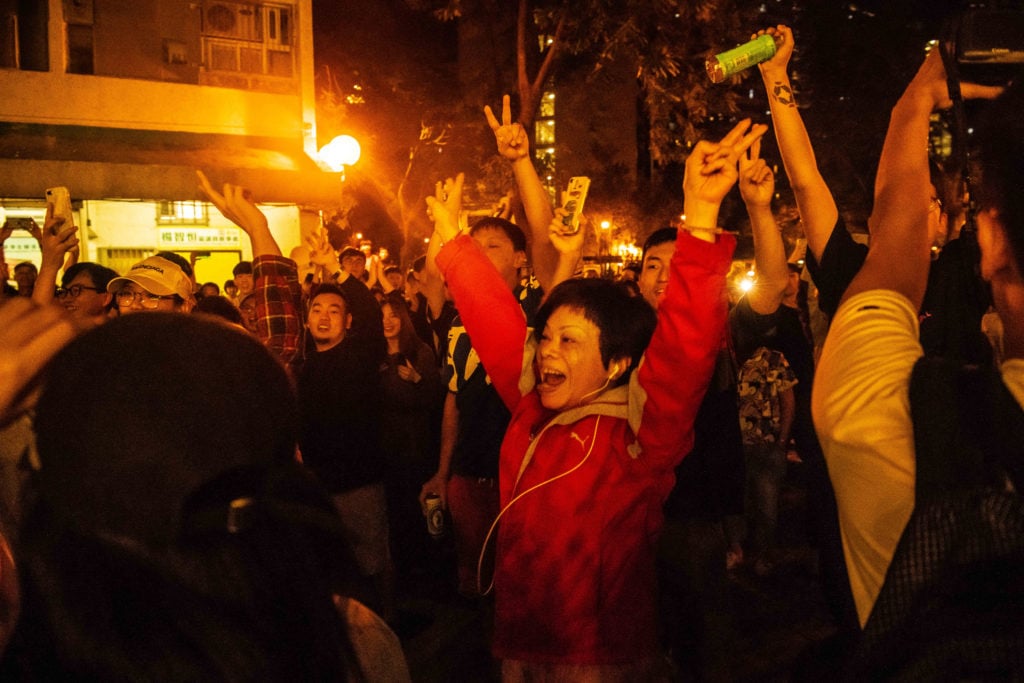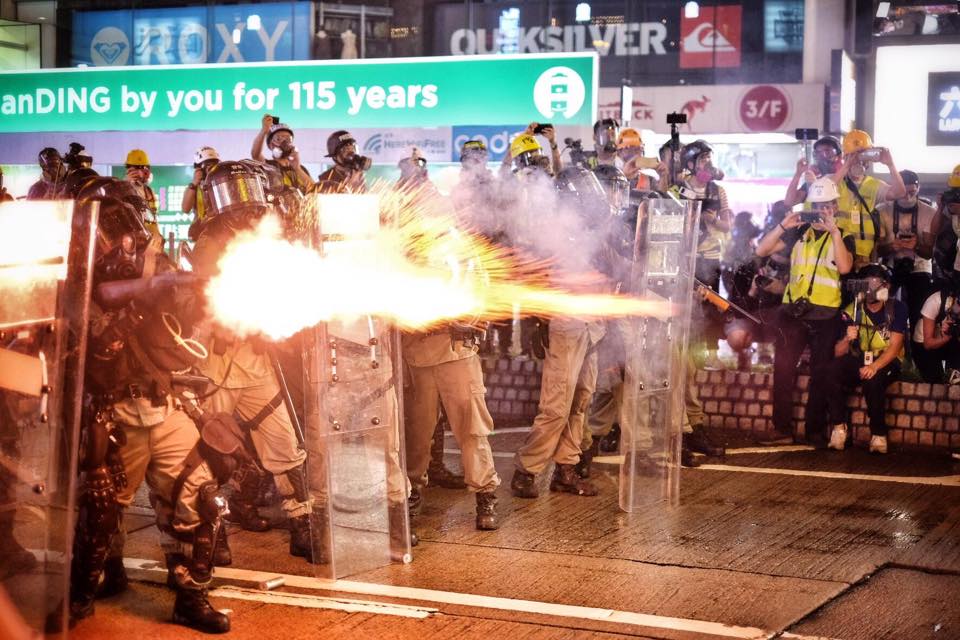Politics
A Surprising Number of Artists Were Elected to Hong Kong’s District Council. What Comes Next?
Many of the artists who ran were surprised to actually win. Now, they promise to bring creative thinking to their new roles.

Many of the artists who ran were surprised to actually win. Now, they promise to bring creative thinking to their new roles.

Vivienne Chow

Late in the evening of November 24, Hongkongers were joyously smiling and laughing for the first time in nearly six months. They were celebrating the landslide victory of the pro-democracy camp in the District Council elections, which were widely seen as a de facto referendum on the ongoing protests that have been gripping the city since June. The record turnout rate of 71.2 percent—2.94 million registered voters—collectively voted out the pro-Beijing camp, which ended up winning only 59 out of 452 seats.
With the pro-democracy contingent controlling the council for the first time, the election results ushered in a new chapter in Hong Kong politics. But they were also a milestone for an unlikely contingent: Hong Kong’s arts and cultural scene. Never had the city seen such a significant number of artists and cultural practitioners taking part in an election—and winning. And these newly elected district councillors vow to bring artistic thinking into policymaking.
“In recent years, the growth of community art and socially engaged art have brought artists closer to the society and politics,” said the artist and curator Clara Cheung, one of the newly elected pro-democracy district councillors. “The next step is to take action within the system and make changes.”
As both artists and passionate citizens, she said, “we hope our way of thinking can influence the community… to cultivate our culture and the city’s cultural identity from a community level.”
The Hong Kong protests sparked by the now-withdrawn extradition bill in June have morphed into a broader pro-democracy movement. These weeks of activism have been widely regarded as a political awakening for many Hongkongers, artists among them. Despite peaceful beginnings, with millions of people taking to the streets, the protests have become violent at times. There have been increasing clashes between police and frontline protesters, resulting in more than 5,000 arrests and over 10,000 tear gas canisters fired, with young demonstrators shot with live rounds. One young protester died from falling from a building during a clash. In mid-November, university campuses became battlegrounds as they were besieged by the police. Just before the District Council election the US Congress passed the Hong Kong Human Rights and Democracy Act, which allows the US to annually review the city’s status as a special trading entity separated from mainland China, and place sanctions against those who undermine the city’s autonomy. President Donald Trump signed it into law after the election.
Hong Kong holds elections every four years for the city’s Legislative Council and District Council. The Legislative Council is a lawmaking body and their election is based on proportional representation, with only half of the 70 seats open to public votes. The majority of the district council members, on the other hand, are directly elected. Council members serve as advisors for the government, weighing in on local affairs and the allocation of funding for district use.
November’s District Council elections saw at least seven artists or cultural professionals running, the most robust political participation from the city’s arts community since artist Chow Chun-fai’s bid in the Legislative Council election in 2012. Many have said that they took part only to ensure that a pro-Beijing candidate would have some competition. The triumphant outcome was unexpected.

Pakkin Leung, newly elected to the District Council, captured this picture of police clashing with protestors.
In addition to Clara Cheung, elected district councillors with an arts background include Law Wai Shan, manager of the Art & Cultural Outreach (ACO), which oversees the Foo Tak Building, an artists’ hub in the Wan Chai district; sculptor and arts educator Wong Tin-yan; artist and incumbent district councillor Clarisse Yeung; and Pakkin Leung, a photographer and photojournalist who has been covering the protests on the front lines.
Artist Kacey Wong, best known for his protest art, helped with Cheung’s campaign. He said the election has given artists an unprecedented opportunity to reinvent themselves. They are no longer confined to simply reflecting their feelings and observations through art that is exhibited in galleries and museums.
“Chow Chun-fai set a very good example back then, showing fellow artists that an artist’s life and career are not limited by his body of work,” Wong said. “He was using the society as his canvas.”
The artists recently elected to the District Council, he added, will in some ways be “running a four-year art project, where the stage and the setting is the community.”
But at the same time, of course, they will also be doing the real work of governing. “Being a district councillor means that they have to deal with various power sects, from those on the government level to local community, as well as those executing the will of the Beijing,” he noted. “They also have to deal with the mundane paperwork and meetings. Do artists have such stamina? Time will tell us the results.”
“The people I have dealt with, from government officials to well-educated professionals from the community, they tend to obey the structure,” said Clarisse Yeung, 32, who has successfully retained her seat in the council of Wan Chai. “If those from above say ‘no,’ they dare not challenge the order. There is a lack of imagination. But coming from a fine art background, I can see things differently.”
Wan Chai district on Hong Kong Island is a hybrid commercial and residential area that has a number of cultural landmarks, including the Hong Kong Arts Centre, the Academy for Performing Arts, and the historic Blue House cluster. It is where Art Basel Hong Kong and all the major art auctions take place. It is also where the police headquarters are, bordering the government offices and Legislative Council building, which has been a site of intense protests. The district also has the biggest number of elected councillors coming from an artistic background.
A graduate of the Chinese University’s fine art department, Yeung is an enthusiast of cultural policy. Four years ago, she joined a new generation running for District Council election for the first time after the 2014 Umbrella Movement died down without any of its pro-democracy demands met.
Yeung said being a district councillor means that she has to help local residents to fight for their benefits, from reviving a cancelled bus route to getting an ATM installed in their neighborhood. But she has applied her fine art training during her battles with local officials, helping to visualize the issues at hand. At one meeting with local officials to demand the revival of a cancelled bus route, she brought along a large cardboard bus to make her point.

Clarisse Yeung asks officials to imagine the benefits of bringing back a cancelled bus route.
“When they see the model of the bus it reminds them of the bus route they need,” she said. “We also organized a cultural tour of the bus route to explain the cultural and historical context of this bus route.”
Yeung formed a coalition, Kickstart Wan Chai, bringing 10 like-minded candidates together. The group ended up winning six out of the 13 seats in Wan Chai district. Susi Law is also a member of this group. “With more councillors with artistic backgrounds, it will be easier for us to [make] culture-related proposals,” she said.
Clara Cheung ran her campaign in the Happy Valley constituency, a historic and posh neighborhood that is home to the privately-run F11 Foto Museum and V54, an artist-in-residence program housed in a three-story historic building built in a French style.
Cheung co-founded C&G Apartment, an independent art space that responds to social and cultural issues. Running an election campaign for the first time, the 40-year-old approached it much like curating a community art project tailor-made for this district. She came up with events meant to bond the community, such as tours around the neighborhood to encourage participants to develop new ways of seeing, and playful events for families.
“Participants will reflect what kind of environment they want to live in,” said Cheung. “They will develop an artistic way of seeing and critical thinking. Then they will take action next.”
Pakkin Leung, 39, studied fine art at the Hong Kong Arts School at the Arts Centre in Wan Chai and has been working in the district. He ran an election campaign four years ago but lost to the pro-Beijing candidate.
This time around, he beat the long-serving pro-Beijing district councillor without even showing up for his election campaign—he chose instead to document the protesters trapped inside the Polytechnic University lockdown as the campus was besieged by the police for more than 10 days.
Coming from both an artistic and journalistic background, Leung hoped to bring culture to the neighborhood by documenting and studying the community in an artistic way. Leung said he wanted to become a district councillor who cares about people’s needs. His determination stems from the brutality he has witnessed on the frontline of the protests, including shooting one of the most important videos that captured the police’s indiscriminate attacks on unarmed civilians in a subway station on August 31.
“I’ve photographed with tear gas canisters and bullets flying over my head,” he said. “We need to reflect the community’s voices and engage the community’s participation through ongoing cultural projects, and show people the truth.”
How things will pan out for Hong Kong after this four-year District Council term is over is beyond these artistic district councillors’ imaginations. But Cheung remains hopeful.
“I hope we will have universal suffrage by then. But as of now, we can make a difference in our community and build solidarity to keep this movement moving forward,” Cheung said. “I do not see this movement ending until we have universal suffrage, which is our most basic right. We cannot stop, otherwise we would lose everything.”